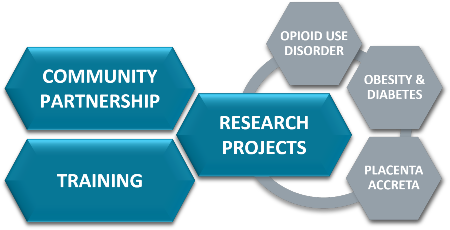Research Components of the Center

OBESITY & DIABETES
Stress and epigenetic alteration in the prognosis and benefit of exercise of obesity-induced maternal mortality and morbidity.
AIM 1
To determine whether maternal obesity-induced cellular stress and epigenetic alterations in the placenta and the mother predict the incidences of SMM and MM during pregnancy and postpartum.
AIM 2 To determine whether heightened placental and systemic stress and epigenetic modifications mediate the additive effect of maternal diabetes or hypertension on SMM and MM.
AIM 3 To determine whether the increased physical activity/dietary control during pregnancy and postpartum reduces the occurrence of SMM and MM in mothers with obesity by preventing placental and systemic stress and epigenetic changes.
PLACENTA ACCRETA
Precision detection, biomarker discovery and uterine vasculature monitoring in placenta accreta-related maternal mortality and morbidity.
AIM 1 To determine the precision of refined ultrasound imaging in the early detection of placenta accreta in high-risk patients.
AIM 2 To investigate whether our Complex Obstetrics Program significantly reduces blood loss at delivery leading to SMM and MM reduction in placenta accreta pregnancy.
AIM 3 To determine the predictive value of placental exosome cargos in placental accreta trophoblast invasiveness and angiogenesis.
OPIOID USE DISORDER
Neuronal markers and an evidence-based patient self-monitoring mobile application in preventing opioid use disorders and depression in pregnant and parenting people.
AIM 1 To determine whether functional exosome cargos derived from neurons can reveal the degree of opioid use disorders, depression, and their relationship.
Aim 2 To determine whether endoplasmic reticulum stress can predict opioid tolerance and relapse.
Aim 3 To establish and validate an evidence-based patient-self monitoring mobile application in the reduction of SMM and MM in opioid use disorders.
